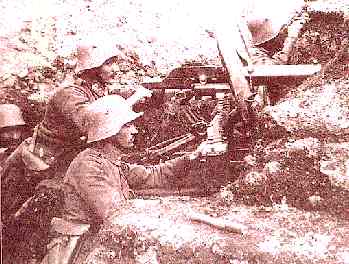The Story of the American Expeditionary Forces |
 3rd Division |
Tactical Case StudyNight AttackIn the Argonne |


|
Now since the division commander had ordered that the trench 800 yards north of the Bois de Cunel be taken on the 10th and since the 1st Battalion had failed to do this and was unable to make a second effort in time, the 2d Battalion of the 30th Infantry and one company of the 7th Infantry were directed to attack the hostile position at 10:00 p.m. The northwestern edge of the wood was designated as the line of departure for the 2d Battalion and the northeastern edge for the company. There would be no artillery support.  Sector MapThe attack was launched on time. Exactly two and a half hours had elapsed since the Germans had been subjected to a heavy artillery preparation, following which the attack of the 1st Battalion had failed to materialize. When no attack followed this 7:30 p.m. bombardment, the Germans apparently concluded that the Americans would make no further effort that night.  German Machine Gun PositionBy this time every vestige of organization had disappeared. Many company, platoon and section leaders were casualties. The reserve company was completely intermingled with the assault companies. All was confusion. Immediate steps were taken to reorganize the battalion, while a message requesting reinforcements was sent to the regimental commander. At 2:30 a.m. the battalion commander reported to the regimental command post. He informed the colonel that the 2d Battalion was now occupying the trench in the zone of the 30th Infantry and had established contact with the company from the 7th Infantry on the right, but that reinforcements were necessary on the left, where the enemy still held the trench in considerable force. One company was promptly dispatched to this dangerous flank and after severe fighting drove the enemy from his position.  German Dead in Trench
Not all of the missing were casualties. Many men who could not be accounted for had merely lost their way in the darkness. DISCUSSION. Here most of the conditions essential to the success of a night operation are evident: The battalion knew the terrain. It was close to its clearly defined line of departure. It was placed opposite its objective. The objective was limited and was unmistakable even in the dark. The troops had not been engaged during the day and were therefore comparatively fresh. Details of the attack were carefully explained by the battalion commander. The movement was made in silence, great care being taken to avoid alarming the enemy. The attack was made at a time when the Germans had concluded that no further effort would be made that night. All of these factors made for success.  American Troops Entering a Village Similar to CunelThe figures giving the effective strength of units indicate the disorder which may attend even a successful night attack. True, the companies were depleted at the start but, even so, the small effective strength at the conclusion of the operation is striking. |
|
Sources and thanks: From the personal experience monograph of Major Turner M. Chambliss, who commanded the 2d Battalion of the 30th Infantry. This case study was presented in INFANTRY IN BATTLE, a survey of infantry tactics of the World War selected and with commentary by the Faculty of the Infantry School at Fort Benning under the direction of Colonel George C. Marshall. Regular contributors Ray Mentzer and Herb Stickel provided the Photos. MH |
To find other Doughboy Features visit our |
Membership Information  Click on Icon |
For further information on the events of 1914-1918
visit the homepage of |
Michael E. Hanlon (medwardh@hotmail.com) regarding content,
or toMike Iavarone (mikei01@execpc.com) regarding form and function.
Original artwork & copy; © 1998-2000, The Great War Society
